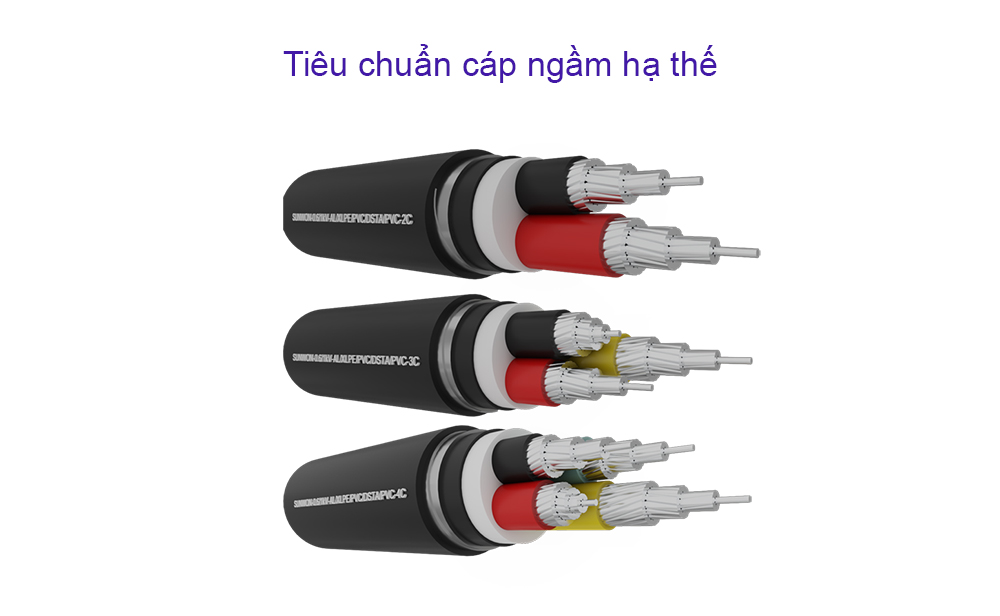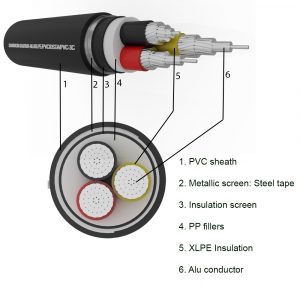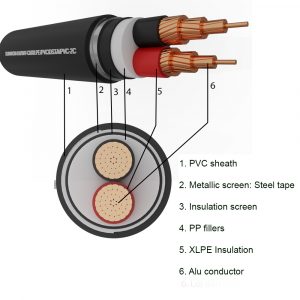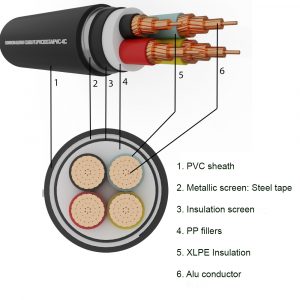Low-voltage underground cable is an electric cable placed underground, used to transmit voltage up to 1kV and is specified in TCVN 5935-1:2013, TCVN 7997:2009. Inside:
- TCVN 5935-2:2013 regulates the structure of production of electric cables and test methods;
- TCVN 7997:2009 specifies the method of installation.
TCVN 5935-1:2013 regulates structure of low voltage underground cables
1. Rated voltage
The rated voltages Uo/U(Um) of the cables considered in this standard are 0.6/1 (1.2) kV and 1.8/3 (3.6) kV.
2. Insulating compound
| Insulating compound | Shortened symbol |
| a) Thermoplastics.Polyvinyl chloride is used for cables with rated voltage Uo/U £1.8/3 kV | PVC/A* |
| b) Horizontal linkEthylene propylene rubber or the like (EPM or EPDM)
Molecular rubber or ethylene propylene rubber with high hardness Cross-linked polyethylene |
EPR
HEPR XLPE |
| * Polyvinyl chloride based insulating compounds used for cables with rated voltage Uo/U = 3.6/6 kV are denoted PVC/B in IEC 60502-2. | |
The highest conductor temperatures for the different classes of insulating compounds covered by this standard are given in the table below:
| Insulating compound | Maximum conductor temperature 0C |
|||||
| Work as usual | Short circuit (longest time is 5s) |
|||||
| Polyvinyl chloride | (PVC/A)Cross section of conductor £300 mm2.
Cross section of conductor >300 mm2. |
70 70 |
160 140 |
|||
| Cross-linked polyethylene | (XLPE) | 90 | 250 | |||
| Ethylene propylene rubber | (EPR and HEPR) | 90 | 250 | |||
3. Coating compound
| Coating compound | Shortened symbol | The highest temperature of conductor in normal operation 0C |
| a) ThermoplasticsPolyvinyl chloride (PVC)
Polyethylene
Halogen-free b) Elastic material Polychloroprene, polyethylene chlorosulfonate or similar polymers |
ST1
ST2 ST3 ST7 ST8
SE1 |
80
90 80 90 90
85 |
4. Conductor
Conductors shall be class 1 or class 2 of uncoated or coated annealed copper or of aluminum or aluminum alloy or class 5 of uncoated or coated copper in accordance with IEC 60228.
5. Insulation
a. Insulating materials; The insulation shall be an extruded dielectric of one of the two classes listed in the first Table.
b. PVC/A . insulation thickness
| Nominal cross-sectional area of conductor mm2 |
Nominal thickness of insulation at rated voltage Uo/U (Um) |
|
| 0.6/1 (1.2) kV mm2 |
1.8/3 (3.6) kV mm2 |
|
| 1.5 and 2.54 and 6
10 and 16 25 and 35 50 and 70 95 and 120 150 185 240 300 400 500 to 800 1 000 won |
0.81.0
1.0 1.2 1.4 1.6 1.8 2.0 2.2 2.4 2.6 2.8 3.0 |
––
2.2 2.2 2.2 2.2 2.2 2.2 2.2 2.4 2.6 2.8 3.0 |
| NOTE It is not recommended to use conductors with cross-sections less than the values given in this table. | ||
c. Insulation thickness XLPE
| Nominal cross-sectional area of conductor mm2 |
Nominal thickness of insulation at rated voltage Uo/U (Um) |
||
| 0.6/1 (1.2) kV mm2 |
1.8/3 (3.6) kV mm2 |
||
| 1.5 and 2.54 and 6
10 and 16 25 and 35 50 70 and 95 120 150 185 240 300 400 500 630 800 1 000 won |
0.70.7
0.7 0.9 1.0 1.1 1.2 1.4 1.6 1.7 1.8 2.0 2.2 2.4 2.6 2.8 |
––
2.0 2.0 2.0 2.0 2.0 2.0 2.0 2.0 2.0 2.0 2.2 2.4 2.6 2.8 |
|
| NOTE It is not recommended to use conductors with cross-sections less than the values given in this table. | |||
d. Insulation Thickness EPR/HEPR
| Nominal cross-sectional area of conductor mm2 |
Nominal thickness of insulation at rated voltage Uo/U (Um) |
|||
| 0.6/1 (1.2) kV mm2 |
1.8/3 (3.6) kV mm2 |
|||
| EPRmm | HEPRmm | EPRmm | HEPRmm | |
| 1.5 and 2.54 and 6
10 and 16 25 and 35 50 70 95 120 150 185 240 300 400 500 630 800 1 000 won |
1.01.0
1.0 1.2 1.4 1.4 1.6 1.6 1.8 2.0 2.2 2.4 2.6 2.8 2.8 2.8 3.0 |
0.70.7
0.7 0.9 1.0 1.1 1.1 1.2 1.4 1.6 1.7 1.8 2.0 2.2 2.4 2.6 2.8 |
––
2.2 2.2 2.2 2.2 2.4 2.4 2.4 2.4 2.4 2.4 2.6 2.8 2.8 2.8 3.0 |
––
2.0 2.0 2.0 2.0 2.0 2.0 2.0 2.0 2.0 2.0 2.0 2.2 2.4 2.6 2.8 |
| NOTE It is not recommended to use conductors with cross-sections less than the values given in this table. | ||||
6. Multi-core cable assembly, inner sheath and filler
a. Inner coating and filler
The inner wrap can be extruded or wound. For cables with round cores, except cables with more than five cores, a wound inner covering is allowed only if the space between the cores is substantially filled.
The material used for the inner covering and filler shall be suitable for the operating temperature of the cable and compatible with the insulating material.
Extrusion inner coating thickness
| Assumed diameter of arranged core | Thickness of extruded inner coating (approximate value) mm |
|||
| Larger than mm |
To and equal to mm |
|||
| –25
35 45 60 80 |
2535
35 60 80 – |
1.01.2
1.4 1.6 1.8 2.0 |
||
Thickness of wrapped inner layer
The approximate thickness of the wound inner covering shall be 0.4 mm for the assumed diameter of the arranged core up to and including 40 mm and 0.6 mm for larger diameters.
7. Metal curtain
The metal screen shall be one or more ribbons, or a woven mesh or a layer of concentric wire, or a combination of wires and ribbon(s).
8. Metal armor
The types of armor covered by this standard are as follows:
- flat wire or round wire armor: Round wire or flat wire shall be galvanized steel, tinned copper or copper, aluminum or aluminum alloy.
- dual-strip armour: The ribbon must be steel, galvanized steel, aluminum, or aluminum alloy. Steel strip shall be hot-rolled or cold-rolled of commercial quality.
NOTE For cables of rated voltage 0.6/1 (1,2) kV with a cross-sectional area exceeding 6 mm2, armor can be provided in the form of a woven galvanized steel wire mesh according to the agreement. agreement between manufacturer and purchaser.
View products
Low Voltage Cables
Low Voltage Cables
Low Voltage Cables
Low Voltage Cables
4-cores underground aluminum cable SUNWON-0.6/1kV-AXSV 3x+1x
Low Voltage Cables
Low Voltage Cables
Low Voltage Cables
Low Voltage Cables

















